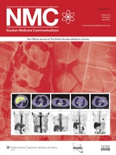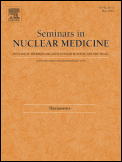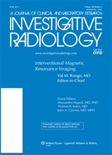
EJNMMI Radiopharmacy and Chemistry
Scope & Guideline
Transforming analytical chemistry into therapeutic solutions.
Introduction
Aims and Scopes
- Radiopharmaceutical Development:
The journal publishes research on the synthesis, characterization, and evaluation of new radiopharmaceuticals, focusing on their potential applications in imaging and therapy. - Automated Radiosynthesis:
A significant emphasis is placed on automated synthesis techniques that improve the production efficiency and reproducibility of radiopharmaceuticals, ensuring compliance with GMP standards. - Theranostic Applications:
Research articles often explore theranostic approaches that combine diagnostic imaging and targeted therapy, particularly in oncology, using radiolabeled compounds. - Quality Control and Regulatory Compliance:
The journal addresses best practices in quality control and regulatory frameworks for the production of radiopharmaceuticals, ensuring safety and efficacy in clinical settings. - Innovative Imaging Techniques:
There is a consistent focus on novel imaging methods and probes, including PET and SPECT, aimed at enhancing the diagnostic capabilities in various medical conditions, particularly cancer.
Trending and Emerging
- Precision Medicine and Targeted Therapies:
There is a growing emphasis on developing radiopharmaceuticals that are tailored for specific patient populations and disease types, particularly in cancer therapies, showcasing the trend towards personalized medicine. - Novel Radiometals and Radionuclides:
Research focusing on the use of new radiometals and radionuclides for imaging and therapeutic applications is on the rise, indicating a shift towards exploring alternatives to established isotopes. - Microfluidics and Automated Production Techniques:
Innovations in microfluidic systems for the production of radiopharmaceuticals are emerging as a key trend, enhancing the efficiency and scalability of radiotracer synthesis. - Biodistribution and Pharmacokinetics Studies:
An increased focus on understanding the biodistribution and pharmacokinetics of radiopharmaceuticals is evident, which is crucial for optimizing their clinical applications and improving safety profiles. - Regulatory Frameworks and Patient Access:
Research addressing the regulatory landscape and strategies to enhance patient access to radiopharmaceuticals is gaining traction, reflecting the importance of policy in the advancement of the field.
Declining or Waning
- Conventional Radiopharmaceuticals:
Research on traditional radiopharmaceuticals is becoming less frequent, as the field shifts towards more advanced and specific targeting agents, particularly in oncology. - Basic Radiochemistry Techniques:
While foundational radiochemistry methods remain important, there is a noticeable decline in publications focused solely on basic synthesis techniques without innovative applications or improvements. - Generalized Quality Control Practices:
There is a trend away from generic quality control discussions, as the journal increasingly emphasizes specific and novel methodologies tailored to particular radiopharmaceuticals.
Similar Journals

Revista Espanola de Medicina Nuclear e Imagen Molecular
Pioneering Insights in Radiology and Molecular ImagingRevista Española de Medicina Nuclear e Imagen Molecular, published by Elsevier España SLU, stands as a vital resource in the field of Radiology, Nuclear Medicine, and Molecular Imaging. With an ISSN of 2253-654X, this journal is committed to disseminating high-quality research and advancements in clinical practices, aiming to bridge the gap between theoretical research and application in healthcare. Operating since 2012, it features a robust archive of peer-reviewed articles and case studies, although it currently holds a Q4 ranking in the Scopus category, indicating significant potential for growth and influence within the academic community. The journal is indexed in Scopus, with a rank of 255 out of 333, placing it in the 23rd percentile, which underlines the need for increased contributions from researchers eager to enhance its standing. While it is not an open-access journal, its availability through libraries and institutions ensures that a wide audience can access critical findings and innovations in the rapidly evolving field of nuclear medicine. As we look towards the convergence period from 2012 to 2024, Revista Española de Medicina Nuclear e Imagen Molecular aspires to fortify its role as a cornerstone for collaboration and advancement in nuclear imaging and radiology.

PET Clinics
Pioneering Progress in Positron Emission Tomography.PET Clinics, published by Elsevier Inc, is a premier academic journal focusing on the advancements and applications of Positron Emission Tomography (PET) in various medical fields. With its ISSN 1556-8598 and E-ISSN 1559-7814, the journal has established a strong reputation in the scientific community, reflected in its impressive Q1 quartile rankings in Medicine (miscellaneous), Radiation, and Radiology, Nuclear Medicine, and Imaging for 2023. The journal operates within a well-defined scope that bridges innovative research and practical clinical applications, targeting professionals, researchers, and students keen on the intersection of nuclear medicine and imaging technologies. Although not an open-access journal, PET Clinics ensures accessibility through institutional subscriptions, making valuable insights available to the academic community. With an emphasis on enhancing patient care and treatment outcomes through cutting-edge imaging techniques, this journal serves as an essential resource for those seeking to expand their knowledge and expertise in the rapidly evolving field of PET.

NUCLEAR MEDICINE COMMUNICATIONS
Advancing the Future of Nuclear MedicineNUCLEAR MEDICINE COMMUNICATIONS is a prestigious academic journal published by Lippincott Williams & Wilkins, focusing on the multifaceted field of nuclear medicine and its applications in diagnostics and therapy. With a solid history spanning from 1980 to 2024, this journal provides a platform for peer-reviewed research articles, clinical studies, and innovative techniques that enrich the knowledge base within the fields of {{medicinal applications, patient care, and imaging technology}}. Currently classified in the Q3 quartile for both Medicine (Miscellaneous) and Radiology, Nuclear Medicine, and Imaging, the journal reflects its commitment to advancing healthcare practices. Although it does not offer open access options, its accessibility through reputable institutions promotes scholarly exchange among researchers, professionals, and students alike. The critical insights provided in NUCLEAR MEDICINE COMMUNICATIONS are essential for those dedicated to enhancing patient outcomes through cutting-edge nuclear medical technologies.

Imaging
Empowering Collaboration in Medical ImagingImaging, published by AKADEMIAI KIADO ZRT, is an esteemed open-access journal dedicated to the field of medical imaging, established in 2020. With an E-ISSN of 2732-0960 and based in Budapest, Hungary, this journal provides a vital platform for the dissemination of cutting-edge research and advancements in imaging techniques, especially in the realms of radiology, nuclear medicine, and ultrasound technology. While currently positioned in the Q4 category across multiple medical specialties, the journal continues to strive for improvements in visibility and impact, contributing to the evolving discourse in medical imaging. The journal aims to facilitate an inclusive and collaborative environment for researchers, professionals, and students, inviting them to share their findings and insights to enhance the field's development. With open-access availability since its inception, Imaging ensures free and easy access to its content, fostering a greater understanding and appreciation of innovative imaging practices worldwide.

SEMINARS IN NUCLEAR MEDICINE
Exploring breakthroughs in nuclear imaging.Welcome to Seminars in Nuclear Medicine, a prestigious journal published by W B Saunders Co-Elsevier Inc that has been at the forefront of the field since its inception in 1971. This journal serves as a dedicated forum for researchers, healthcare professionals, and students specializing in the rapidly evolving areas of radiology and nuclear medicine. With an impressive ranking of #29 out of 333 in the Scopus category, drawing an esteemed 91st percentile, it holds a distinguished Q1 category status, highlighting its critical role in disseminating high-quality research and clinical practices. Although it does not operate as an Open Access publication, Seminars in Nuclear Medicine remains a vital resource, featuring comprehensive reviews and insightful articles that inform the medical community about the latest advancements and applications within nuclear imaging. This journal not only enhances knowledge but also encourages collaboration among professionals dedicated to improving patient outcomes through innovative nuclear medicine techniques.

NUCLEAR MEDICINE REVIEW
Fostering Global Dialogue in Nuclear MedicineNUCLEAR MEDICINE REVIEW is a distinguished journal in the field of radiology, nuclear medicine, and imaging, published by VIA MEDICA in Poland. Since its transition to an open access format in 1999, this journal has been dedicated to promoting the dissemination of knowledge and research findings across a global audience. With a focus on innovative approaches and advancements in nuclear medicine, it aims to serve as a key resource for researchers, professionals, and students who are working to further the understanding of nuclear imaging and its applications. In 2023, the journal was classified in the Q3 category within Radiology, Nuclear Medicine and Imaging, and Q4 in the broader category of Medicine (miscellaneous), highlighting its growing reputation in the academic community. As of the latest assessments, the journal has been ranked #235 out of 333 in its field according to Scopus metrics, reflecting its commitment to excellence and the relevance of its published works. The NUCLEAR MEDICINE REVIEW is a pivotal platform for those engaged in cutting-edge research, providing insights that drive the evolution of medical imaging and therapeutic techniques.

ANNALS OF NUCLEAR MEDICINE
Connecting Researchers to the Future of Nuclear DiagnosticsANNALS OF NUCLEAR MEDICINE is a prominent academic journal dedicated to the field of nuclear medicine, published by Springer. With a rich publication history dating back to 1987 and continuing through 2024, this journal serves as a vital resource for researchers and practitioners interested in the latest developments in nuclear imaging, radiopharmaceuticals, and therapeutic applications. Ranked in the second quartile (Q2) for both Medicine (miscellaneous) and Radiology, Nuclear Medicine, and Imaging categories in 2023, it maintains a strong position in the academic community, with an impressive Scopus rank of #104 out of 333 in its field, placing it in the 68th percentile. The journal is not open access but offers a range of access options through institutional or individual subscriptions, ensuring that critical research findings reach a wide audience. By fostering high-quality, peer-reviewed articles, ANNALS OF NUCLEAR MEDICINE plays a crucial role in advancing the understanding and practical application of nuclear medicine techniques, making it an essential journal for professionals and students aiming to stay at the forefront of this evolving discipline.

EUROPEAN JOURNAL OF RADIOLOGY
Transforming Patient Care Through Radiological ResearchThe European Journal of Radiology, published by Elsevier Ireland Ltd, is a premier peer-reviewed journal in the fields of radiology, nuclear medicine, and imaging. Established in 1981, it has carved a significant niche within the academic community, showcasing innovative research that enhances medical imaging practices and improves patient care. With an impressive ranking in the Q1 category for both Medicine (miscellaneous) and Radiology, Nuclear Medicine, and Imaging in 2023, the journal is recognized globally for its commitment to advancing scientific knowledge and improving imaging methodologies. The journal's Scopus ranking of #60/333, placing it in the 82nd percentile, underlines its reputation for high-quality research and scholarly contributions. While traditionally a subscription-based journal, it continually evolves to meet the demands of the academic landscape, aiming to bridge the gap between research and clinical practice. Researchers, healthcare professionals, and students alike can benefit from exploring its extensive archives and current publications, which are curated to foster education and innovation in the medical imaging domain.

Molecular Imaging and Radionuclide Therapy
Elevating the standards of molecular imaging research.Molecular Imaging and Radionuclide Therapy is an esteemed academic journal published by GALENOS PUBL HOUSE, dedicated to advancing the fields of radiology, nuclear medicine, and imaging. Since its inception, this Open Access journal has facilitated the dissemination of high-quality research and innovative practices in molecular imaging and radionuclide therapy, making it a vital resource for researchers, professionals, and students alike. With an ISSN of 2146-1414 and an E-ISSN of 2147-1959, the journal has established its presence globally while specifically catering to the Turkish academic and medical community. As of 2023, it is ranked #241/333 in the Radiology, Nuclear Medicine and Imaging category on Scopus, holding a respectable Q3 quartile ranking. The journal serves as a platform for sharing impactful findings from 2017 to 2024, reinforcing its commitment to open access since 2011. With a dedication to enhancing the knowledge base in molecular imaging and therapy, it remains an important conduit for scholarly communication and collaborative research developments in this dynamic field.

INVESTIGATIVE RADIOLOGY
Bridging Research and Clinical ExcellenceINVESTIGATIVE RADIOLOGY, published by Lippincott Williams & Wilkins, is a premier peer-reviewed journal dedicated to disseminating innovative research in the fields of radiology, nuclear medicine, and imaging. With a notable impact factor underscored by its impressive ranking—10th out of 333 in its category, positioning it within the 97th percentile—this journal serves as a vital resource for researchers, professionals, and students eager to stay at the forefront of advancements from 1966 to 2024. Although it does not offer open access, the high-quality studies and reviews found within its pages contribute significantly to the understanding and application of modern imaging techniques. Recognized for its Q1 status in both miscellaneous medicine and radiology specializations, INVESTIGATIVE RADIOLOGY continues to play an essential role in shaping the future of diagnostic and therapeutic imaging.